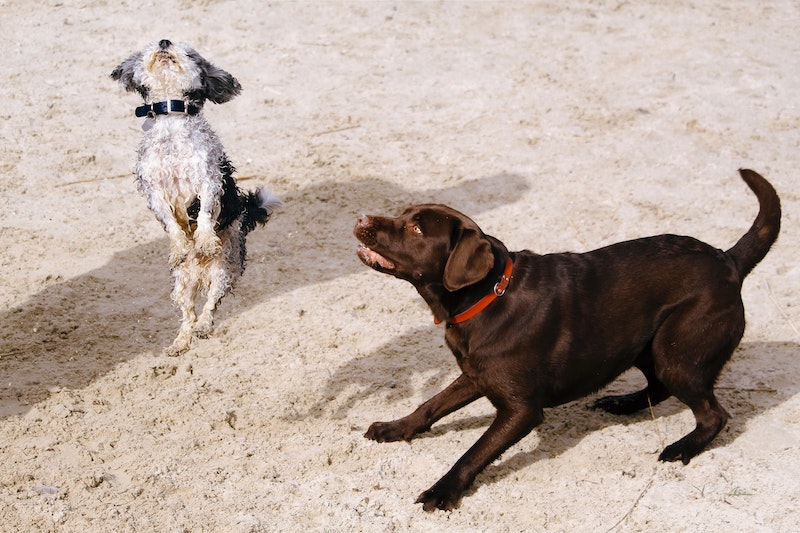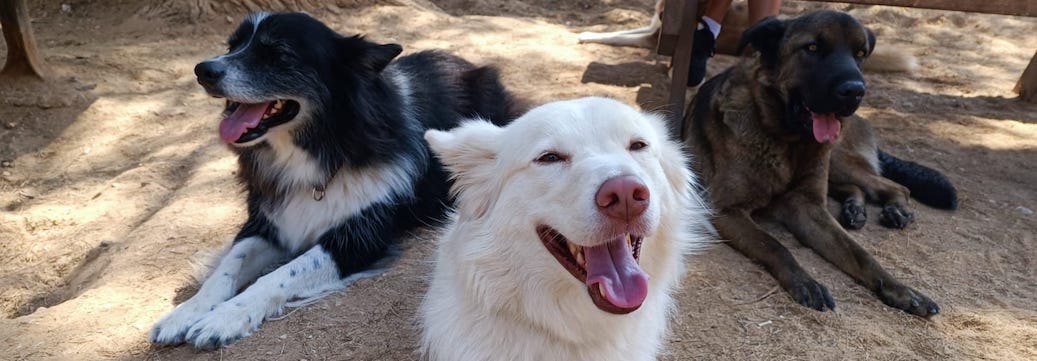At the dog park, your pet has the opportunity to interact and play with other pups—off-leash! That’s something to bark about. It’s a freeing experience, and one that provides valuable socialization, enrichment, and exercise.
But while this is a place where dogs can be dogs, there are still rules and best practices to keep in mind. Good etiquette can help ensure that you and your dog are welcome to return to the park, and it can help to keep you both, and other visitors, safe.
Is your dog fit for the dog park?
Before grabbing your leash, make sure your pup is actually ready for the dog park. If you’re still unsure if the dog park is right for your pup, consult with your vet.
Get your pup vaccinated
You might be eager to socialize your newborn dog ASAP, but take a deep breath. It’s best to only bring puppies who are at least six months old, or who have been fully vaccinated.
A dog of any age should be up to date on all of their vaccinations, since this can help to protect them from diseases that can be spread between dogs. If your dog doesn’t currently receive the Bordetella (kennel cough) vaccine, your vet might recommend that you add that onto your dog’s regular vaccines before heading out to rub shoulders with other canines.
Make sure they’re “fixed”
Only bring a dog who is spayed or neutered to a dog park. Intact dogs are more likely to be aggressive, territorial, and bad-mannered to their fellow dogs. Plus, you wouldn’t want an accidental pregnancy to happen on your watch.
Size does matter
Smaller dogs or puppies might love to play, but bringing your pup into a dog park where they might interact with much larger dogs can be dangerous. If you have a tiny pup, seek out dog parks that have separate play areas for smaller and larger dogs.
Protect your pup against fleas
It’s also essential to make sure your dog is up-to-date on a quality flea and tick treatment, to prevent fleas from spreading to your dog from their playmates, or vice versa. While it’s still possible that your dog might carry some fleas home from the park, an effective flea treatment should quickly kill those fleas—stopping an infestation in its tracks.
Do a quick health check
If your best friend seems a little under the weather, or is showing symptoms like lack of appetite, sneezing, or coughing, it’s best to stay home.
And if your dog is recovering from an injury or surgery, consult your vet before heading to the park. It’d be a shame for a vigorous play session to result in a medical setback.
Get your pup covered
Dogs who work hard and play hard can always benefit from the peace of mind that pet insurance brings. A base accident and illness policy from Lemonade can help cover treatments for unexpected injuries from rough housing, plus Lemonade offers several Preventative Care packages, which can help take the bite out of routine care like vaccines, wellness exams, tests, and even spaying or neutering.
What might I see at the dog park?
Every dog park is different, and they range from bare bones to the height of luxury. But most dog parks have some similar features.
Water stations are common, giving pups access to clean drinking water. Many parks have poop bag stations and trash cans, so you can easily clean up after your dog. Some parks even have agility courses, allowing you and your pup to do light training while you’re there.
At dog parks, you’ll often see an important safety feature: double entrance and exit designs.
These gates are positioned right after each other, creating a small vestibule between them. This allows you to open and pass through one gate, closing it behind you before opening the gate that leads you in or out of the park. These gates help to prevent other dogs from escaping.
Good play vs. bullying

While your dog plays, it’s your job to keep an eye on them. Look out for body language that indicates your dog is enjoying their time at the park.
- A wagging tail that moves in a loose, sweeping motion
- Chasing games with other dogs
- Bouncy, puppy-like movements
- Open-mouthed grins with loose lips
- Play bows
And even if dog play has all the signs of being simply “fun and games”, it might be a good idea to check in with other dog parents just to make sure. Dog mom Pasha Flannery takes this super seriously when taking her pup to the park, “Even if you think the playing is okay, if the owner of the other dog thinks they need a break then take your dog away, especially if my dog is being more of the ‘instigator’ in playtime.”
Pay attention as your dog plays and look for any signs of bullying:
- Overly rambunctious or pushy play
- Placing their paws or head on another dog’s shoulders
- Excessively mounting other dogs
- Pinning dogs to the ground
If you notice these behaviors, safely separate the dogs before a full-on fight breaks out.
And hey, there’s a chance your pup just isn’t a huge fan of the park. They might be reserved, stay close by your side, and give you indications that they’re ready to go. Not all dogs enjoy the environment at the park—and that’s ok!
Okay, so what should I do if a fight breaks out?
If a fight breaks out, despite your impulse, don’t reach down to try to separate the dogs. Doing so could swiftly lead to injury.
Instead, focus on distracting the dogs. If a hose is available, spraying the dogs will often break up a fight. You can also blow an air horn or yell at the dogs to startle them. Once the dogs are apart, immediately leash and further separate them.
Dog park dos and don’ts
Familiarizing yourself with these rules of dog park etiquette can help you and your best friend to have a fun and safe time at the park.
Do:
- Identify on-leash and off-leash areas, and use a leash accordingly. You might think you’re playing it safe by keeping your pup on-leash in the dog park, but you would be mistaken! Dog parent Pri Maheshwari has seen this unfortunate scene play out before with her pup, Marcel. “Leashes restrict the natural movement patterns and the way dogs greet each other, which is why you get leash reactive dogs (like mine). When an unleashed dog goes to greet a leashed dog, it can make the leashed dog feel threatened or uncomfortable.”
- Stop to read and obey the dog park rules for each park you visit
- Clean up after your dog. DUH
- Teach your dog good manners and monitor them closely while they play
- Introduce yourself to other pet parents
- Make sure all of your dog’s vaccines are up-to-date and verify with your vet that your dog is healthy enough to go to the park
Don’t:
- Use any open outdoor space as your pup’s personal dog park
- Train or discipline someone else’s dog
- Let your pup run rampant while you go read a book on a park bench
- Bring treats or dog toys to the park, which can potentially lead to a fight
- Force your dog to play with others or ignore signs that your dog is uncomfortable
- Bring known aggressive dogs to a dog park
- Bring your dog to the park when they’re sick or have fleas
- Bring small children to the park, since playful dogs can easily knock them down.
- Bring your small dog into the large dog area, or vice versa

What should I bring with me to the dog park?
Make sure you’ve packed these key essentials before heading out:
- Water: While many parks have water stations, bring along your own water to be safe. Collapsible bowls can also come in handy.
- Dog poop bags: Many dog parks have these available, but bring your own. Let’s be civilized.
- Pocket-sized air horn: A loud blast from this device can help to break up any too-rough behavior between dogs.
You might be tempted to bring along some treats and toys, but these items can make other dogs jealous and potentially lead to fights. It’s best to leave them at home—you can reward your BFF with extra rewards after you’ve returned from the park.
Dog park alternatives
While dog parks can be fun for many dogs, they’re not the right fit for every pup. Don’t sweat it—there are plenty of other ways you and your best friend can have a great time together.
Consider joining an agility group or taking a dog training class. You can also explore new areas to hike or take up a fun new sport with your dog, like flyball.
Some dogs really enjoy doggy day care groups, which tend to be smaller groups that are closely supervised. If your dog does best with just one-on-one play, then schedule a quiet play date with another dog owner and their pup.
If you’re looking to add some variety to your pup’s life, there are also apps like Sniffspot, which allows dog parents to rent out private yards or parks for their pups to enjoy some care-free time off-leash.
Before we head to the park…
A trip to the dog park can give your dog fantastic exercise and a chance to develop relationships with other pups. Following good dog park etiquette ensures that everyone has a positive experience.
Just like any other adventure you take with your best friend, you’ll need to do some preparation, and always watch your dog closely. This will ensure that your time at the dog park is rambunctious and boisterous—but safe. After a few hours of play, you’ll both be ready for a well-deserved nap.





